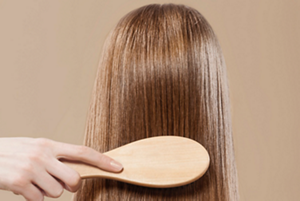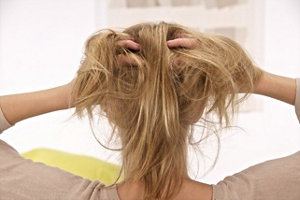HOW TO DEAL WITH THIN OR FINE HAIR
No matter your age or your hair type, thin, fine hair can affect anyone - and it’s a common complaint. According to the NHS, around 8 million women in the UK experience hair loss, and Harvard Health Publishing estimates that around a third of women will be affected at some point in their lives.
It’s normal to lose hair – and every day we can lose 50-100 hairs without even noticing. However, if you’re looking to make your fine hair look thicker, we’ve got a comprehensive guide to making the most of your hair.
What’s the difference between fine and thin hair?
It’s important to understand the difference between fine and thin hair – fine hair describes your hair’s texture and the diameter of your strands, and thin hair describes the overall density of your hair.Fine hair means that your strands of hair are thin, but there can often be plenty of follicles on your scalp. You may have been told by your hairdresser, ‘You’ve got fine hair, but lots of it.’
Thin hair refers to the amount of hair you have on your scalp – you may have fewer follicles per square inch.

Do I have fine or thin hair?
A quick way of working out if you have fine hair is to compare one of your hairs to a length of thread. If your hair strand is thinner than the thread, that may mean you have fine hair. Fine hair can also feel different to coarser hair types – it may feel silkier and flatter after washing, and may not hold up so easily in a ponytail.Another test is to roll a single strand of hair in between your thumb and forefinger. If you can’t feel the strand, you may have fine hair.
If you have thin hair, you may notice that your hair feels lighter, and you may begin to see more of your scalp under bright lights. You may also notice your hair part starting to widen.
What causes hair thinning and hair loss?
There’s no one answer to explain what causes hair loss – but it can be related to a variety of factors.- Hormonal changes, such as having a baby
- Menopause
- Extreme weight loss
- Stress
- Ageing
- Medical issues, such as Long Covid
- Hereditary issues

How can I make my thin hair look thicker?
There are plenty of ways to boost the look of thin hair – and you can approach this from two different ways. You can update your hair care routine, and the hairstyles you wear.Remember that if you have fine hair, you only need to wash your hair 2-3 times a week – use dry shampoo for the days in between washes, and brush through your hair to mop up any excess oil.
Hair care for thin, fine hair
- Don’t shampoo your hair as frequently, and when you do, massage the shampoo in gently – don’t briskly rub or scrub your hair and scalp
- Use a thickening shampoo and thickening conditioner when you wash your hair - our PROfiller+ range gives hair an instant, plumping boost for hair that looks and feels thicker, fuller and stronger
- Use a thickening hair treatment to care for fine, thin strands. Our PROfiller+ Strengthening Super Fluid is infused with Biotin and Hyaluronic Acid and instantly transfers reinforcing proteins deep into the hair
- Build our PROfiller+ Hair Growth Scalp Serum into your haircare routine. This triple-action serum addresses the signs of hair loss, improves visible hair growth, and increases hair density for fuller, thicker, and healthier-looking hair.
- Apply conditioner sparingly, and to your ends only – the hair closest to your scalp will get oily faster, and conditioning it will lead to flat roots. Our Volume Lift Weightless Silk Strengthening Water is a lightweight post-shampoo rinse to add silky, glossy shine without the weight
- Towel dry your hair gently and use a soft microfibre turban after you hop out of the shower
- If you blow dry your hair, only dry it until it’s 75% dry – to add volume, tip your head upside down and blow dry your roots to add extra shape and volume
- Limit heat styling – and if you do style your hair using heated tools, use a heat protection spray to protect your hair from heat damage
- Brush your hair daily. Not only will this stimulate blood flow to your scalp and encourage hair growth, it’ll also help avoid tangles which can lead to breakage
- Maintain regular haircuts. It sounds counter-intuitive, but regular haircuts can help you keep your hair strong and even grow it, as thin, fine hair is prone to split ends
- If you fancy investing in some overnight care, a silk bonnet or silk pillowcase can help protect your hair during the night. As your hair glides over the silk, there’s less friction and it’s less damaging – leaving you with smoother hair in the morning
Hairstyles for thin hair to add volume
We’ve written a definitive guide on hairstyles for fine hair, but it’s always worth mentioning some of our favourite styles to add volume and definition to fine hair.- Choppy bobs: The best haircuts for thin hair add layers and texture, and a choppy bob with well-sculpted layers will add definition and movement. Style with a volumising mousse to add plenty of lift
- Graduated bob: A classic or asymmetrical bob suits shoulder length hair and above, as long as the edge is straight
- Pixie cut: This short and sweet crop adds both texture and volume, and it’s easy to style. As well as being practical, it’s also easy to maintain and cuts down on drying time
- Choppy, dishevelled lob: This longer bob makes use of cleverly-structured layers to add bounce – add a spritz of root booster to keep your roots full of body
- Stacked bob: This classic bob adds a dimension of volume to thin hair by adding precisely-cut layers to create a rounded bob shape. The shortest hair is at the nape of your neck, and the length gradually move forwards towards your face, adding movement and dimension

How to prevent thin hair
Sometimes there’s no way to prevent thin hair - however, you can start good habits early to discourage thinner hair later in life.- Make sure your diet’s rich in plenty of fresh fruit, vegetables and proteins like fish and eggs
- Maintain good scalp health – brush your hair gently every day and make time for the occasional scalp massage to stimulate blood flow
- Talk to your GP about any appropriate vitamin supplements you can take




